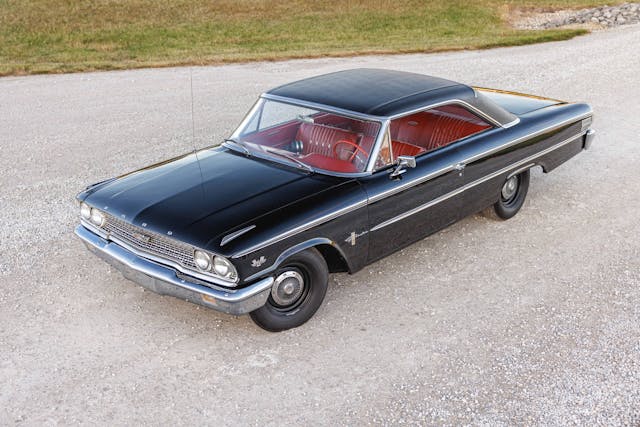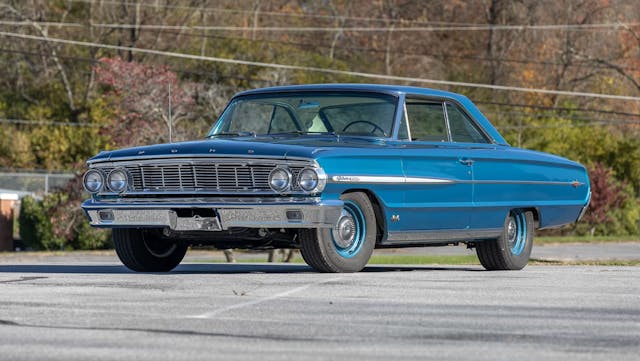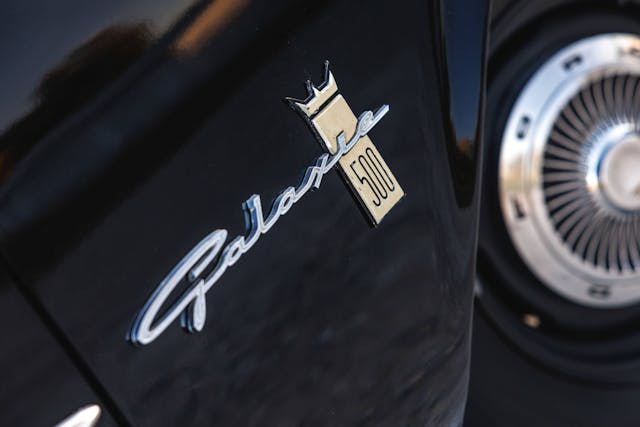1960–64 Ford Galaxie values have taken a journey to the stars
America couldn’t get enough of the space race in the late ’50s and early ’60s. Seemingly everything carried the theme, from consumer products to TV programming to automotive design. Ford eagerly got into the mix, and introduced the Galaxie as the top trim name for the Fairlane 500 in 1959. The Galaxie became its own model the following year and didn’t look back. Now, as collector cars, Galaxies have quietly—and significantly—increased in value.
The Galaxie found itself in constant evolution after it branched off from the Fairlane. Its debut in 1960 presented a step away from the frippery of 1950s design and toward a cleaner, more streamlined look. A swath of engines were available, from a 223-cubic-inch straight-six to a trio of powerful 352-cubic-inch V-8s. Despite the new look and power under the hood, however, sales tumbled to 289,268 from 1959’s 464,100. Couple that with the fact that cross-town Chevy had a winner on its hands in its full-size cars, and particularly the Impala, Ford had to stay on its toes and decided on an immediate update.

1961 brought styling that could be considered less distinctive but that was more in line with conventional tastes. Full, round taillights came back, and the fins, while still carrying a style line from the front door to the back of the car, grew more vestigial. Up front, the grille’s shape was simplified. Alongside these updates came the availability of the 390-cubic-inch FE V-8 making 375 horsepower. Stronger still was the 6V 390, which was Ford’s odd way of sharing that the engine came with three two-barrel carburetors sitting atop an aluminum intake manifold. In this guise, the 390 made 401 horses and 430 lb-ft of torque. Production began to rebound, falling just shy of 350,000 units.

Fins left the Galaxie for good in 1962, the same year that brought the phrase “Xtra Lively” into the mix. That’s what the XL stood for in the new 500 XL trim, which positioned itself against the Impala SS. The 500 XL featured sportier finishes inside and out, along with standard bucket seats and a center console. Two versions of the 406-cubic-inch V-8 became available, though the 352 and 390 mills remained.

1963 was a big year for the Galaxie. Sales, which had been trending upward with Ford’s constant tweaks, peaked that year at 648,010 cars. It was also when Ford introduced the “Total Performance” marketing campaign for the brand, and the famous 427-cubic inch V-8 between the Galaxie’s front fenders. The Sports Hardtop, with a more-raked-but-not-quite-fastback treatment to the rear roofline, became available as well, helping Galaxie-driving NHRA and NASCAR teams with a welcome aerodynamic complement to the added power of the 427. The Galaxie was now a force to be reckoned with on the sales sheets and on the track.

With the winning formula determined, Ford only made minor visual changes in the ‘64 model year, the final one of the Galaxie’s second generation. The Sports Hardtop became the standard roof design for all non-wagon, fixed-roof Galaxies, and engine choices remained the same as those from 1963.
These regular improvements in the breed (and GM’s official withdrawal from racing) led to more than a couple of trophies for the Galaxie. Perhaps its biggest victory came at the hands of Dewayne “Tiny” Lund at the 1963 Daytona 500. Lund got his chance to race for the Wood Brothers that year after their driver, Marvin Panch, was injured in a sports racer ahead of the 500. Ford finished first through fifth that year, boosting the Galaxie’s popularity, while Lund’s win helped set the course for the Wood Brothers to secure the NASCAR Owner’s Title.

The Galaxie’s prowess wasn’t limited to turning left or hitting the quarter mile, however. Jack Sears piloted a ’63 Galaxie (as well as a Jag and a Mini) to the British Saloon Car Championship. In a beautiful display of period saloon-car racing, touring car pilot Sam Tordoff’s impressive drive from last to third in 2020’s Goodwood Speedweek is an ample reminder that big doesn’t have to mean unwieldy.
Despite its capability, the Galaxie isn’t widely considered as popular a canvas for customization as the Impala. While not all Hagerty insurance policies indicate modifications, 6.7 percent of ’60–64 Galaxies are noted as modified, while 12.7 percent of ’61–64 Impalas are so listed. Interestingly, values for both suggest that modified examples are more prized than those left stock, with values for modified Galaxies and Impalas sitting at 37 and 45 percent higher, respectively.
Speaking of values, between engine choices, body styles, and trims within the Galaxie’s second generation, we could create dozens of valuation charts. To simplify things, we picked #2 (Excellent) condition values for three coupes—which, along with convertibles, are at the top of the valuation heap in terms of body selection—using varying trim and engine choices from the final year, 1964. Naturally, 427-powered cars lead the way, and they have done so to a dramatic degree, skyrocketing over 65 percent in value since the beginning of the pandemic boom. More entry-level cars with the 392- and 352-cubic-inch engines have also seen healthy bumps in value, but crucially, all have held their place in orbit even as the market has cooled over the last year. The average value for Galaxies listed with Hagerty in 2023 is about $21,800, so despite some flashy numbers up top, it is possible to get into this big Ford for reasonable money.
Quote data, a metric we use to infer who is buying specific models, has risen among Gen X and younger buyers for the Galaxie over the last four years. Gen X interest is up just under seven percentage points since 2020, while millennial and Gen Z interest is up about four percentage points. That said, interest in the Galaxie among folks under 40 still lags their overall share of the market.
These early Galaxies proved their mettle through regular refinement and evolution. Their proven reputation on track didn’t hurt, either. While the Galaxie might not be as emblematic of its era as the Impala, their values have demonstrated that enthusiasts believe Galaxies belong in the firmament of full-size muscle.

***
Check out the Hagerty Media homepage so you don’t miss a single story, or better yet, bookmark it. To get our best stories delivered right to your inbox, subscribe to our newsletters.



Those big block versions worked well as moonshine tankers back in the day. I saw one outrun a Tennessee Highway Patrol car one night in ’66.
Somebody must not have heard that prohibition ended in 1933.
But illegal stills are all over the southeast US and randomly scattered in other areas. There is still money to be made selling moonshine because there’s no tax. Liquor is taxed $13.50 per gallon as a “production tax” and there’s another 20.5% tax on liquor sold to consumers at retail stores, but restaurants and bars only get taxed 13.7% on liquor sales. On top of those taxes, add state taxes. Moonshiners have a market because of the high taxes. Same reason there are still illegal marijuana grows in states where recreational cannabis is legal. The illegal grows pay no state or local taxes that are typically 25% to 40%.
Are you that clueless? Illegal liquor stopped when prohibition stopped? Lol
The key here is the Convertibles, Coupe with big engines and light weight high performance models are the only ones of value here and they account for a very small portion of the cars built.
I had a sedan even with the 352 that was very clean. It was not worth much then nor now,. I did make money on it as I paid little for it. It only had 70K miles and was all original including the exhaust.
The only thing it was good for was to make into a Mayberry police car.
I did put a set of original Anson wheels from the 60’s and removed the silvertown bias tires that were still on it.
It was a good car but it just was not one of those from the small slice that had the right number of doors and bigger engine.
Mine would run too. In fact it was great to run hard as no one ever gave you a second look.
The police cars tended to be the cheaper Fords (Ford Customs in the ’50s. I guess Fairlanes in the ’60s). Galaxies would’ve been out of reach for Mayberry.
I just purchased a 2 door ’60 with a YBlock and manual transmission. A FE will be slid in at some point. It’s a survivor, so I’m excited.
Fairlane was still fullsize for 60 and 61 only.
My grandma had a 61 convertible I always loved even though she never once put the top down. Remember the 62 xl’s nice, but the 63’s xl’s were the ultimate interior , Ford went all out on that interior. Never heard XL was for “extra lively” before. Must have led a sheltered life
One lady refused to buy one. Said it was bad enough that her underwear had “XL” on it. She didn’t want that on her car.
4 door Ford Galaxy 500. I would love to see one.
Thanks
I have a 72 4 door for sale if your interested
I just got a 63 4door is back on the market very nice car all white exterior red interior
I prefer the coupes. The convertibles are not my favorite with the tops up. Not my favorite look.
Modern day fads, in particular the current trend of blackwall tires and poverty hubcaps were on full display in this article.
I own a black 60 Sunliner (bought it in 1979) just like the one in the photo, and I would never put black walls and hubcaps on it. It’s a premium model in the lineup and deserves white walls and full wheel covers. I would also never “garbage it up” with all the dealer options like bumper guards, hood ornament etc. etc. that I see on most latter day ’60’s. These are still commonly found NOS at swaps, because anybody with a modicum of taste eschewed these trinkets ‘way back.
I’ve endured decades of “why would you want that ugly 60”. Looks like that attitude is changing. I’ve always thought they were extremely handsome- since they were new.
I’d never put hubcaps and blackwall tires on my ’60; makes the car look cheap. They’re appropriate on a base stripper Fairlane.
In all honesty, I’ve owned many ’60-64 Fords, and the quality control in ’60 was pretty poor, but by ’64 Ford built a solid, quality car.
I’ve never warmed up to the ’62’s.- except the great XL interior. They, and the ’58’s were Ford’s styling pariahs. ’62 too bland, ’58 strange.
I was also puzzled why every car in this article had blackwalls and hubcaps. Definitely not a popular look back in the 60’s. Galaxies look much better with the whitewalls and wheels covers they all had back in the day. My Dad had a new 64 Galaxie (with whitewalls and wheel covers), and I still think it was one of the prettiest cars of that era.
There was a reason police cars wore poverty caps and blackwalls. They wore through tires quickly and full wheel covers held brake heat and tended to fly off with spirited driving. I would say that look is appropriate for a High performance model. The 2bbl 2dr hardtops
would look more correct with full wheel covers and whitewalls. Of course any owner free to install what they like, then and now.
If that’s the 1960 Galaxie convertible I saw at Mecum Kissimmee 2019 (and I’m pretty sure it is), it had the 352 Y-code 360 HP solid lifter engine with 3-speed manual trans, and was sporting AACA Grand National First Place and Grand National Senior badging. Considering that it had the racy engine and manual transmission, the dog dish hubcaps did not look out of place to me at the time. I think you might agree if you saw this unusual Galaxie in person. The bidders loved it. It was superbly restored and sold for $130K back then.
What? No overdrive? Power windows, seats?
I remember a hipo 352 ’60 Galaxie that I took trim off of… in Pick-a-Part. That was about 40 years ago. The engine was gone, darn it!
I’ll wager that high restoration ’60 came with full wheelcovers and whitewalls new. It’s a convertible, not a stripped sedan drag race car. Looks good today, because, like I said earlier, hubcaps and blackwalls are the current fad.
300 hp and 360hp all had the same Y engine code.
Why would the ’58 Fords be “pariahs” and “strange”? The 57, 58 and 59 Fords were all the same body with trim changes each year. Ford and Chevy were neck and neck for sales in all 3 years. Ford slightly ahead in 57, Chevy slightly ahead in 58 and a dead-heat in 1959. Those years were economic slow-down years and Ford and Chrysler did have enough in the bank to create all new bodies for each of those years. But Chevy did have the money to do new bodies each year. Even fresh and very different styling each year didn’t help Chevy sales much.
Ack! No editing? Ford and Chrysler did NOT have enough money in the bank to make new bodies for 57, 58, and 59.
Nothing was stranger than the 59 Chevy . . . and the build quality of that was a joke.
Learned to drive in a brand new Biscayne . . . so never owned a Chev in my life.
The 406 & 427 Ford Galaxies ran well in NASCAR and were the only competition for Chrysler. GM just had the 409 till 65, I think they went a decade and didn’t win a race till 73 or so.
58 was a Recession . . . build & sales numbers were way down right across the board, which is why you don’t see many Pontiacs, Fords & Chevs that survived from that year.
Learned to drive in a 63 Chevy Carryall with Granny Gear, a 66 VW Bug & a 64 389 Catalina. First car 62 Impala SS. Have had lots of cars, 2 Falcons, 3 early Mustangs, 66 Thunderbird in Fords. Bunch of Mopars, 68 Charger Favorite. The 59 Chevy’s are Cool, have an El Camino, want to put a 348W motor in it, friend had one with a 396. I built a 460 Ford for my Jet Boat. Variety is the Spice of Life. Next project 69 RS/Z28 Camaro then maybe a 351 Cleveland Mustang (67-70?).
The hubcaps and black walls definitely make it look cheap
Kid I went to high school bought a Galaxie with the 3 two barrel engine option, can’t remember much about that car except it was black w/ red interior, 4 speed, 3 deuces and he wrapped it around a tree. It was something back in its day
My dad has a Ford Galaxy 1963.5 convertible. It was originally a salmon pink. But he owned a body shop and so it was painted red and had black interior. If anyone knew him, they knew his red car. When my parents passed my aunt being in control of the estate made us transport the car from California to Maine. I’m still angry because we were told they sold the car at auction for 10k. So we were not only lied to but we never seen the 10k either. I just wonder how much they really got for my dad’s car? It was in good condition. it was built in California and had remained here until they shipped it back east. In other words it was not a rust bucket.
Didn’t the Galaxie start in 1959?
As a trim level for the Fairlane. It was a standalone Galaxie in 1960.
Yes
LOVE MY ’61 SUNLINER WITH A 390, TRIPOWER. WHENEVER I DRIVE IT HEADS START SWIVELING. BRIGHT RED OUTSIDE AND BLK/RED INTERIOR,KELSEY HAYES WIRE WHEELS ,OVERSIZE CRUISER SKIRTS WITH A LARGE BLK. BETTY BOOP DESIGN. PLUS A FULL STRENGTH CONTINENTAL KIT OUT BACK.
wasn’t the black one shown known as a 63 and a half? Then the blue one was ’64.
No mention of the full sized station wagons? I have a 62 Country Squire and a 63 Country Squire with factory bucket seats and center consul. I love these beasts!
I’m lucky enough to have a 61 Starliner that my Grandfather bought new and had been sitting for probably 40 years. 47,000 miles. Paperwork still in glove box. All original with the 292 Y block. Just finished cleaning off 60 years of mud and crud from undercarriage and now finally getting ready to install refurbished engine into restored engine bay and go from there.
My brother has a basket case, very rough 61 Starliner with the rare dealer installed 4 speed factory 390
Where are the station wagons??
Brandon, South Dakota
I learned to drive in a light blue 1964 2-door Custom, straight 6, 3 on the tree, no radio.
No way I would pay $20000 today.
I’ve had 2, a ’63 XL 2D convertible and a ’64 2D HT. Both awesome cars. Sold the XL about 15 years ago and the ’64 a couple of years ago. The XL was a trailer queen, but the HT was a daily. Got it sans engine (and a lot of other parts) and put a 260 V8 in it that I had since it had a 5 bolt bell housing.
Miss them both.